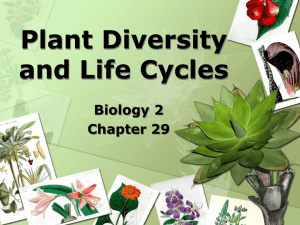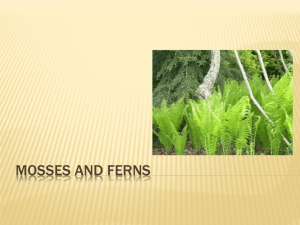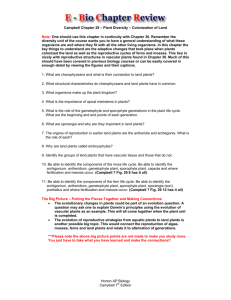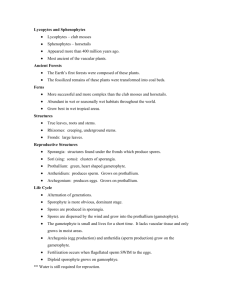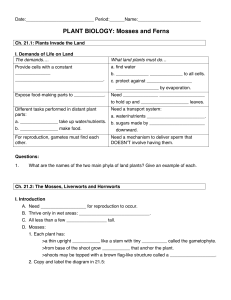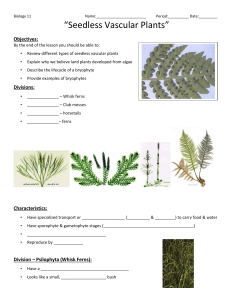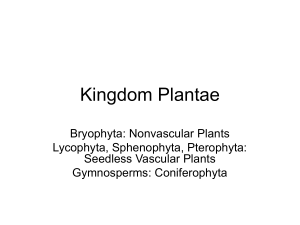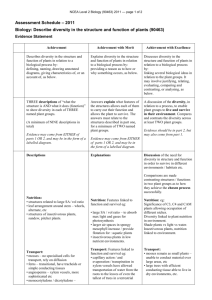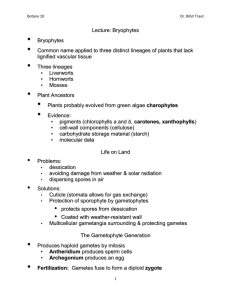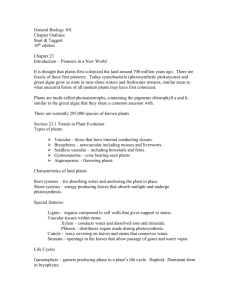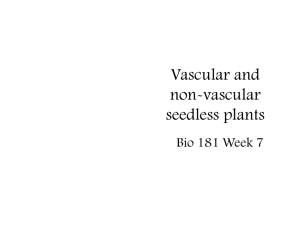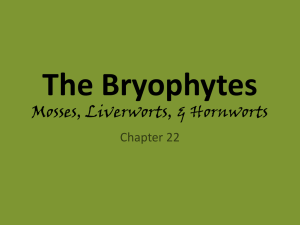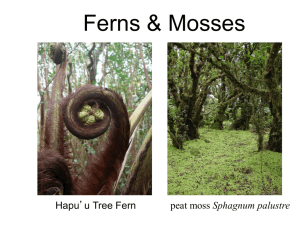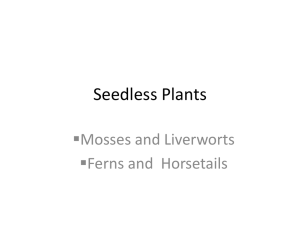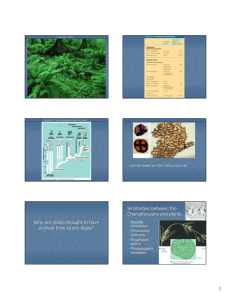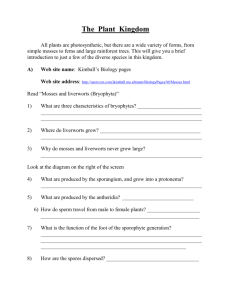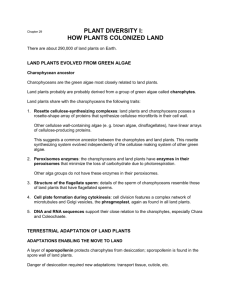Lab-6-Plant-Diversity-1
advertisement
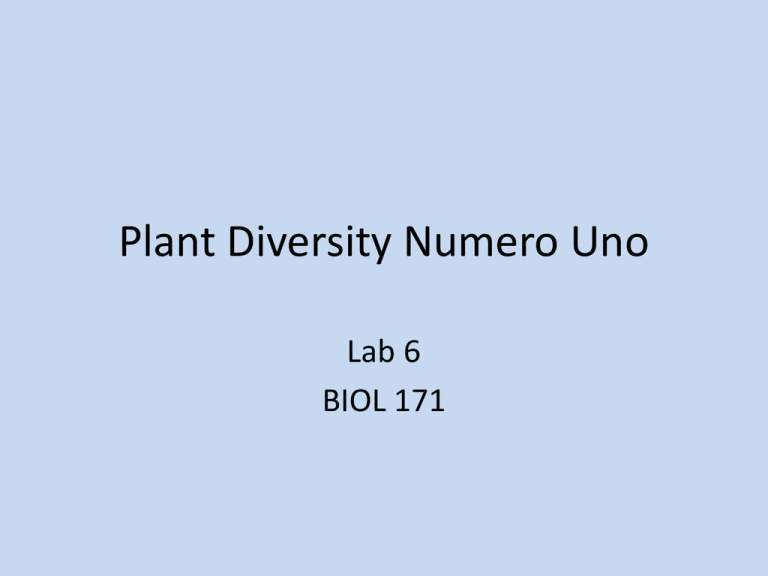
Plant Diversity Numero Uno Lab 6 BIOL 171 Introduction First land plants were related to green algae – 500 million years ago Plant Life Cycles • All land plants have a common sexual reproductive life cycle called alteration of generations • Gametophyte – haploid (n) generation • Sporophyte – diploid (2n) generation • One generation is always dominant (more conspicuous) – In the Bryophytes (mosses and liverworts) the gametophyte is dominant – In all other land plants the sporophyte is dominant Alternation of Generations (also look at figure 2 in lab manual) Alternation of Generations Vocab • Spores – (n) produced by the sporophyte generation through meiosis – germinate (undergo mitosis) to produce the gametophyte (n) • Sporangium – a protective nonreproductive jacket that contains the spores • Gametes – produced inside the gametangia located on the gametophyte – Eggs (n) are produced inside the archegonia through mitosis – Sperm (n) are produced inside the antheridium through mitosis • Zygote – (2n) formed by fusion of the gametes, this is the first stage of the sporophyte generation • Note: the archegonia and antheridium may occur simultaneously in the same gametophyte, but on difference branches. Non-vascular Plants • 3 Phyla: – Bryophyta (mosses) – Hepatophyta (liverworts) – Anthocerophyta (hornworts) • Small plants, lacking vascular tissue (specialized cells for transport of material) • The gametophyte generation is dominant and conspicuous plant. • Restricted to moist habitats – Because they lack vascular tissue – And because this enables their mobile sperm to swim and fertilize the egg • Have a cuticle, but lack stomata on the surface of the thallus (plant body) Bryophyta (mosses) • Most common group • Occurs in moist environments, but also found in dry habitats that are periodically moist Peat moss (Sphagnum) Hepatophyta (liverworts) • Flattened and lobed thallus (plant body) • Early herbalists believed that these plants were could treat liver disorders. (based on the doctrine of signatures) • Found along streams on moist rocks • Very small Liverwort body form • Rhizoids – root-like extensions on the lower surface of the thallus • There are pores on the leaf-like thallus that function in gas exchange, but lack guard cells so are always open. • Gemmae cups are located on the upper surface of the thallus, they are circular cups that contain flat disks of green tissue called gemmae. • The gemmae are washed out of the cups when it rains, and they grow into new, genetically identical liverworts. (asexual reproduction!) Seedless Vascular Plants • Two phyla: – Lycophyta (club mosses) – Pterophyta (ferns, horsetails, whisk ferns). • Depend on water for external fertilization and development of the unprotected, free-living embryo. • Lived in vast swampy areas during the Carboniferous period, but declined as Earth became drier. • The fossilized remains of the swamp forests are the coal deposits we mine and use today. Seedless Vascular Plants • All have vascular tissue (specialized for conducting water, nutrients, and photosynthetic products). • Alternation of generations where the sporophyte is dominant and the gametophyte is usually independent of the sporophyte. • These plants have stomata and structural support tissue. • Still retain primitive feature of motile sperm that requires water for fertilization, thus the gametophyte is small and only in moist habitats Lycophyta (club mosses) • Found in moist habiats (i.e. bogs, streamsides) • One species of Selaginella, the resurrection plant, lives in deserts! • Produce two kinds of spores (heterospory). – Megaspores – large spores that produce female gametophytes – Microspores – small spores that produce male gametophyte Lycopodium strobili sporophyte microspores megaspores Pterophyta (ferns, horsetails, whisk ferns) • Until recently these three groups of seedless vascular plants were placed in separate divisions: Pterophyta (ferns), Sphenophyta (horsetails), and Psilophyta (whisk ferns). • New molecular evidence has shown that they are all closely related, thus they are all now in the division Pterophyta. Psilophytes (whisk ferns) • Small, dichotomously branched (repeated Y-branches), photosynthetic stems that reproduce by aerial spores. • Found today in some areas of Florida and in the tropics. Sphenophytes strobili Sphenophytes (horsetails) • Have green jointed stems with occasional clusters of leaves or branches. • Their cell walls contain silica that give the stem a rough texture. • Occasionally used by pioneers to scrub dishes – thus they were commonly called the scouring rushes. • In cooler regions of North America they grow as weeds along roadsides. Pterophyta (ferns) • Most successful group of seedless vascular plants. • Occupy habitats from the desert to tropical rain forests. • Most are small plants that lack woody tissue, except the tree ferns found in tropical regions. rhizome roots
